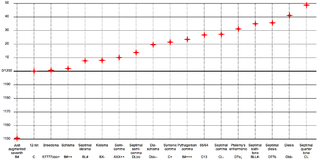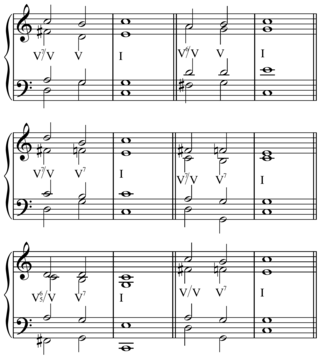In music, a glissando is a glide from one pitch to another. It is an Italianized musical term derived from the French glisser, "to glide". In some contexts, it is equivalent to portamento, which is a continuous, seamless glide between notes. In other contexts, it refers to discrete, stepped glides across notes, such as on a piano. Some terms that are similar or equivalent in some contexts are slide, sweepbend, smear, rip, lip, plop, or falling hail. On wind instruments, a scoop is a glissando ascending to the onset of a note achieved entirely with the embouchure, except on instruments that have a slide.
In music, an octave or perfect octave is the interval between one musical pitch and another with double its frequency. The octave relationship is a natural phenomenon that has been referred to as the "basic miracle of music", the use of which is "common in most musical systems". The interval between the first and second harmonics of the harmonic series is an octave.

In music, harmony is the concept of combining different sounds together in order to create new, distinct musical ideas. Theories of harmony seek to describe or explain the effects created by distinct pitches or tones coinciding with one another; harmonic objects such as chords, textures and tonalities are identified, defined, and categorized in the development of these theories. Harmony is broadly understood to involve both a "vertical" dimension (frequency-space) and a "horizontal" dimension (time-space), and often overlaps with related musical concepts such as melody, timbre, and form.

In music, especially regarding musical notation and tuning, two pitch classes have enharmonic equivalence when they are considered to produce the same pitch but are "spelled" differently within the naming system being used. This relation naturally extends from pitch classes to notes, chords, intervals, and key signatures. Thus, an enharmonic spelling is an alternative representation of a given pitch class. The term derives from Latin enharmonicus, in turn from Late Latin enarmonius, from Ancient Greek ἐναρμόνιος, from ἐν ('in') and ἁρμονία ('harmony').
A variety of musical terms are encountered in printed scores, music reviews, and program notes. Most of the terms are Italian, in accordance with the Italian origins of many European musical conventions. Sometimes, the special musical meanings of these phrases differ from the original or current Italian meanings. Most of the other terms are taken from French and German, indicated by Fr. and Ger., respectively.

In music, unison is two or more musical parts that sound either the same pitch or pitches separated by intervals of one or more octaves, usually at the same time. Rhythmic unison is another term for homorhythm.
Dorian mode or Doric mode can refer to three very different but interrelated subjects: one of the Ancient Greek harmoniai ; one of the medieval musical modes; or—most commonly—one of the modern modal diatonic scales, corresponding to the piano keyboard's white notes from D to D, or any transposition of itself.
The Aeolian mode is a musical mode or, in modern usage, a diatonic scale also called the natural minor scale. On the white piano keys, it is the scale that starts with A. Its ascending interval form consists of a key note, whole step, half step, whole step, whole step, half step, whole step, whole step. That means that, in A aeolian, you would play A, move up a whole step to B, move up a half step to C, then up a whole step to D, a whole step to E, a half step to F, a whole step to G, and a final whole step to a high A.

The Violin Concerto in D minor, Op. 47 of Jean Sibelius, originally composed in 1904 and revised in 1905, is the only concerto by Sibelius. It is symphonic in scope and included an extended cadenza for the soloist that takes on the role of the development section in the first movement.

Braille music is a braille code that allows music to be notated using braille cells so music can be read by visually impaired musicians. The system was incepted by Louis Braille.
The Locrian mode is the seventh mode of the major scale. It is either a musical mode or simply a diatonic scale. On the piano, it is the scale that starts with B and only uses the white keys from there. Its ascending form consists of the key note, then: half step, whole step, whole step, half step, whole step, whole step, whole step.

A Landini cadence, or under-third cadence, is a type of cadence, a technique in music composition, named after Francesco Landini (1325–1397), a blind Florentine organist, in honor of his extensive use of the technique. The technique was used extensively in the 14th and early 15th century.

In music theory, voicing refers to two closely related concepts:
- How a musician or group distributes, or spaces, notes and chords on one or more instruments
- The simultaneous vertical placement of notes in relation to each other; this relates to the concepts of spacing and doubling

In music, a fifteenth or double octave, abbreviated 15ma, is the interval between one musical note and another with one-quarter the wavelength or quadruple the frequency. It has also been referred to as the bisdiapason. The fourth harmonic, it is two octaves. It is referred to as a fifteenth because, in the diatonic scale, there are 15 notes between them if one counts both ends. Two octaves do not make a sixteenth, but a fifteenth. In other contexts, the term two octaves is likely to be used.
Ionian mode is a musical mode or, in modern usage, a diatonic scale also called the major scale.

Playing a string harmonic is a string instrument technique that uses the nodes of natural harmonics of a musical string to isolate overtones. Playing string harmonics produces high pitched tones, often compared in timbre to a whistle or flute. Overtones can be isolated "by lightly touching the string with the finger instead of pressing it down" against the fingerboard. For some instruments this is a fundamental technique, such as the Chinese guqin, where it is known as fan yin, and the Vietnamese đàn bầu.

The string section is composed of bowed instruments belonging to the violin family. It normally consists of first and second violins, violas, cellos, and double basses. It is the most numerous group in the standard orchestra. In discussions of the instrumentation of a musical work, the phrase "the strings" or "and strings" is used to indicate a string section as just defined. An orchestra consisting solely of a string section is called a string orchestra. Smaller string sections are sometimes used in jazz, pop, and rock music and in the pit orchestras of musical theatre.

Maria Gloriosa, or the Erfurt Bell, is a well-known bell of Erfurt Cathedral, cast by Geert van Wou in 1497. The world's largest medieval free-swinging bell, it is now swung electrically. It was welded in 1985 to repair a crack, then, in August 2004, the bell was re-fused due to another crack from 2001.
A monotonic scale is a musical scale consisting of only one note in the octave. Having a deliberate fixed note, the monotonic is still a musical form rather than a total absence of melody. The monotonic stands in contrast to more common musical scales, such as the pentatonic and modern, common Western heptatonic and chromatic scales.
Abbreviations in music are of two kinds, namely, abbreviations of terms related to musical expression, and the true musical abbreviations by the help of which certain passages, chords, etc., may be notated in a shortened form, to the greater convenience of both composer and performer. Abbreviations of the first kind are like most abbreviations in language; they consist for the most part of the initial letter or first syllable of the word employed—as for instance, p or f for the dynamic markings piano and forte, cresc. for crescendo, Ob. for oboe, Fag. for bassoon. This article is about abbreviations used in music notation.













